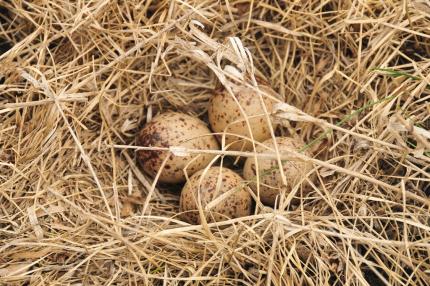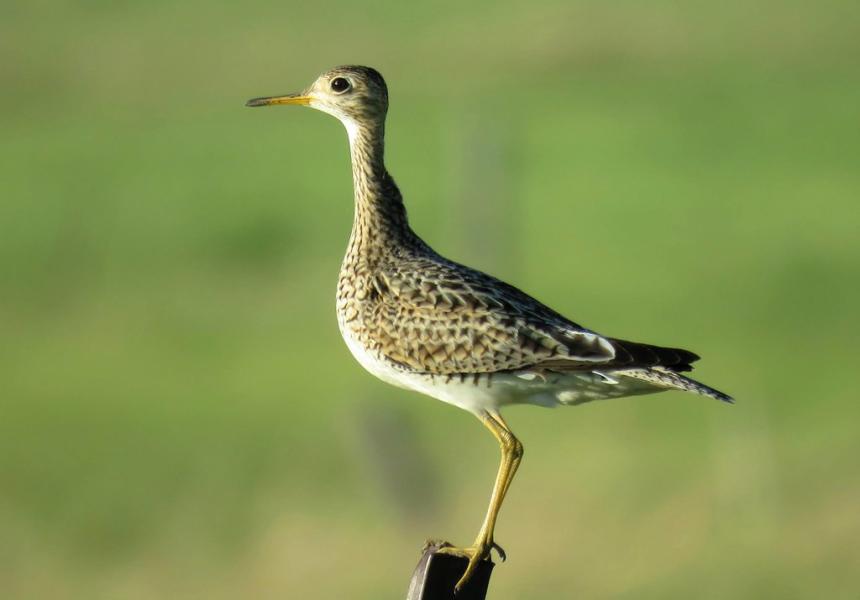Habitat loss most likely contributed to the population decline of upland sandpipers in Washington. Incomplete information on distribution prevents meaningful protection should there be breeding birds in the state. Lack of records suggests it no longer breeds in Washington.
Description and Range
Physical description
The upland sandpiper is about 12 inches in length. It is mottled brown above and has a lighter mottled underside. It has a slender neck and small head. Legs are yellow.
Ecology and life history
During migration, the upland sandpiper is found in a variety of open habitats with relatively short or sparse vegetation such as plowed fields, airports, golf courses, beach dunes, and sod farms.
The species feeds almost exclusively on insects, especially grasshoppers and crickets, weevils, and other small invertebrates gathered from or close to the ground. Occasional seeds of weeds, grasses, and waste grains, including wheat, are also consumed.
Upland sandpipers are inconspicuous and are typically detected when giving courtship calls in flight or while on a perch such as a wooden fencepost.

The species nests in wet meadows with relatively tall grasses. Nests are situated on the ground where the loosely woven cup of grasses is well concealed.
Upland sandpipers feed almost exclusively on insects, especially grasshoppers and crickets, weevils, and other small invertebrates gathered from or close to the ground. Occasional seeds of weeds, grasses, and waste grains, including wheat, are also consumed.
Geographic range
Upland sandpipers may no longer exist as a breeder in Washington, although comprehensive surveys in potential habitat away from documented historical breeding areas have not been conducted. As a breeder in eastern Washington, the upland sandpiper's known distribution in the state has always been very limited. Breeding was documented at Turnbull National Wildlife Refuge and in the Spokane Valley.
Regular observations were made in this area from the mid-1950s into the late 1980s. Virtually all habitat in the Spokane Valley has been converted, and migrants are rare in Washington.
For maps of range-wide distribution and conservation status of this species, check out NatureServe Explorer and the International Union for Conservation of Nature Red List.
Climate vulnerability
Sensitivity to climate change
Moderate
Very limited information is available regarding the sensitivity of upland sandpipers to climate change, particularly in Washington. In the Midwest, upland sandpipers have exhibited some sensitivity to increasing temperatures, with earlier spring migration arrival positively correlated with increasing temperature. Declines in their preferred grassland and wet meadow habitat have already contributed to possible extirpation of the upland sandpiper in Washington; climate changes such as altered precipitation patterns that lead to further habitat loss will negatively impact this species. Altered fire regimes that remove shrubs and promote grasses may benefit this species.
Exposure to climate change
Moderate
- Increased temperatures
- Changes in precipitation
Conservation
Conservation Threats and Actions Needed
- Resource information collection needs
- Threat: Need to assess current distribution and abundance of species.
- Action Needed: Identify areas of habitat within likely range; conduct breeding season surveys.
- Threat: Protection status of habitat.
- Action Needed: Need to assess current distribution and protection status of habitat.
See the Climate vulnerability section above for information about the threats posed by climate change to this species.
Resources
References
Houston, C. S. and D. E. Bowen, Jr. 2001. Upland Sandpiper (Bartramia longicauda). The Birds of North America 580:1-32.
Mlodinow, S. G. 2005. Upland Sandpiper (Bartramia longicauda). Page 145 in T. R. Wahl, B. Tweit, and S. G. Mlodinow (eds.) Birds of Washington: Status and Distribution. Oregon State University Press, Corvallis, OR, USA. 436 pp.
